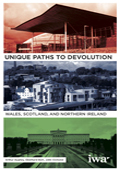Joao Morais reviews Peter Lord’s ‘The Tradition’, an illustrative portrayal of Welsh art and history
To mark his win of the Creative Non-Fiction Award at Wales Book of the Year we are republishing this review of Peter Lord’s “The Tradition: A New History of Welsh Art 1400-1990”, which originally featured in the Welsh Agenda, Spring 2016.
The Tradition is an important book not only for those with an interest in art but also for those who would like to better understand the history of this nation. Peter Lord has spent 30 years as a leading figure in the field, due to his television and radio work as well as his position as a research fellow at the CREW Research centre at Swansea University. Since his previous three-volume study on Welsh art, The Visual Culture of Wales, went out of print, Wales has been without a guide to this vital aspect of our history. With this book, Lord has done the nation a favour.
Lord does a great job of bringing importance to the historical margins in a place that has often been portrayed as marginal. Starting at the turn of the fifteenth century, for instance, we find that much fine woodwork in Wales had been lost due to the revolt against Henry IV’s English rule instigated by Owain Glyndŵr and the following Wars of the Roses later that century.
Much of the early part of the book deals with religious iconography, before moving on to consider the portraiture and landscape paintings of later centuries. It includes many well-known pictures, such as the Alfred Janes portrait of a young Dylan Thomas, but also more recent discoveries. At St Cadoc’s Church in Llancarfan in the Vale of Glamorgan sits a well-preserved painting of St George and the Dragon, painted circa 1455, which lay covered from the 1540s until restoration work began in 2010. Far from being the patron saint of England (at the point of being covered), St George was a well-known figure all over western Europe, famed for his chivalrous nature and devotion to God. Such paintings, once common, show that far from being an unsophisticated periphery of the provincial gwerin, Wales was part of the ‘mainstream’ trail which followed the influence of Rome.
One of the most important aspects of the book comes in its descriptions and argument showing the development of a Welsh art practice. This was firstly made possible due to the patronage of the gentry, but would later go on to be usurped by the patronage of the emerging middle class. Restrictive laws following the civil war of the seventeenth century on careers in public office and obtaining a university education placed on those who would later describe themselves as Nonconformists, and the popularity of that strain of Christianity in Wales, meant there was less art produced in this period than others. But a change in attitudes brought faces to the names of many of those figures involved in the sixteen or so religious Revivals in Wales from 1750-1850. Hugh Hughes’s miniatures of Methodist Leaders, following the Bala sasiwn (secession) of 1811, are particularly noteworthy for the way they resulted in the iconisation of many religious figures. Christmas Evans, who was portrayed always with one eye closed from an injury sustained in an ambush by former friends after a visit to a fair when he was seventeen, was one such. If ever the line ‘you should have seen the other guy’ was uttered in real life, it was surely by this colourful and charismatic Welsh preacher.
The book details 500 years of art in its 400-odd pages, but a full third of it is dedicated to the art of Wales post 1914. The Celtic Revival, started in the early twentieth century, was followed by the ravages of war that brought forth new ways of thinking which made their way into the Modernist movement. Here the book comes into its own, laying out the wild imagination of David Jones to the rise of the 56 group. It also details the Arts Council’s response to the public’s feeling of alienation from abstract art, which resulted in a series of public art commissions in the sixties. Noting the indifference of the public, Lord writes that ‘the commissioning body were applying the same top-down principles as the high-minded improvers of the nineteenth century,’ thus ironically showing that they had learned nothing.
Lord ends his study in 1990, owing to his direct involvement and own influential presence by then in the Welsh art world. Lord is graciously observant of his own restrictions and biases to acknowledge this. If only he were not so tactful so we could have a few pages more.
All articles published on Click on Wales are subject to IWA’s disclaimer.





Comments are closed.